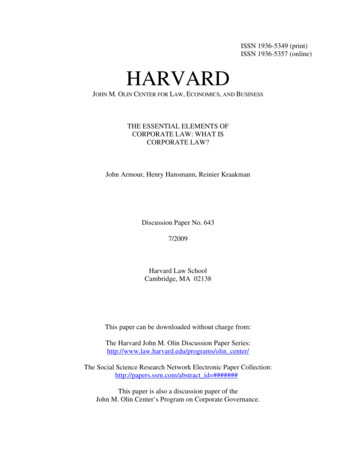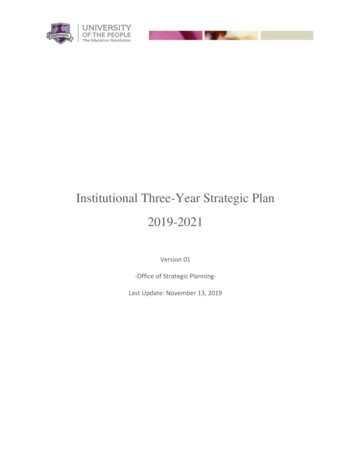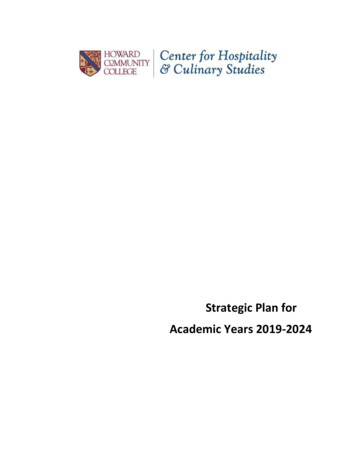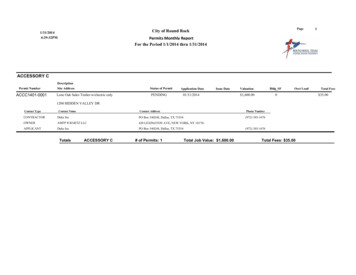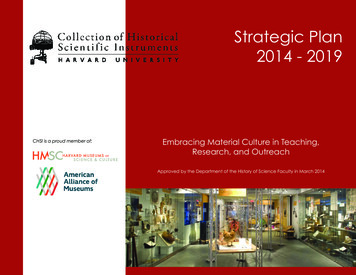
Transcription
Strategic Plan2014 - 2019CHSI is a proud member of:Embracing Material Culture in Teaching,Research, and OutreachApproved by the Department of the History of Science Faculty in March 2014
STRATEGIC PLAN, 2014-2019Embracing Material Culture in Teaching, Research, and OutreachFollowing in the footsteps of David P. Wheatlandthe Collection of Historical Scientific Instruments(CHSI) is successfully continuing a collectionmanagement policy aimed at safeguarding the past,present, and future of Harvard’s thriving scientificheritage. In recent years, enormous efforts dedicated to creating a fully documented inventoryhave born substantial fruits. Our collection management system has radically enhanced daily collection activities, and owing to Waywiser, our newlyredesigned online database, 60% of the collection isnow accessible on the Web. More instruments arecoming online every month.“A laboratory oflaboratories”Since its inception in 1948, theprimary mission of the Collectionof Historical Scientific Instrumentshas been to promote understanding of the place of science insociety by integrating materialculture into research, teaching,and wider educational andpublic programs.Moreover, we have embarked over the last severalyears on an ambitious exhibition and pedagogical program. We strongly believe our collection ofscientific instruments offers one-of-a-kind learningopportunities to a variety of people: faculty,undergraduate and graduate students, postdoctoralfellows, visiting scholars, critical media artists,and the wider public. Our renewed ambition is tocreate a dynamic learning space — a laboratory oflaboratories — that will inspire and cultivate objectbased knowledge. We envision the end results togo beyond exhibitions to include art performances,critical film studies, hands-on sessions, and publiclectures. Our recent ventures into the burgeoningfield of digital media encourage us to explore whataugmented reality and virtual components, such asGoogle Glass, can bring to the museum experience.To build on and reinforce our past achievementswe have identified four essential areas of effort forour strategic plan: to acquire new instruments in2keeping with well-considered acquisition policies;to care for the collection within the rubric of professional conservation and security practice; to engagean increasing number of creative minds, centeredon FAS and broadening out to the wider Harvardcommunity and beyond; and to cultivate a thoughtful, innovative, and critical understanding of thematerial culture of science. Taken together, thesecore activities have long been fundamental to theCHSI.The intention behind this five-year strategic planis to maintain the long-term growth of our Collection, while simultaneously helping to support andenrich the academic programs of the Departmentof the History of Science and the campus-widepublic programs of the Harvard Museums of Science & Culture. We strongly believe the time is ripeto demonstrate what a unique Harvard pedagogical experience the CHSI has to offer.Peter L. GalisonJoseph Pellegrino University ProfessorFaculty Director, CHSI
The core mission of the Collection of HistoricalScientific Instruments (CHSI) is to acquire, preserve,document, and care for over 20,000 instrumentsportraying the history of science teaching and research at Harvard from the Colonial period to the21st century. Through its lively exhibit and teachingprograms, web presence, and increasing involvement in critical media practices, the CHSI’s researchactivities and cultural initiatives intersect and bringtogether a multiplicity of academic disciplines andareas of professional museum expertise. The CHSIis both a specialized institution and an experimentalspace, where Harvard faculty and students, instrument scholars and museum experts meet in theproduction of object-based knowledge.Under the Harvard Museums of Science & Culture(HMSC) consortium, the CHSI is connecting withthe wider Harvard community and the generalpublic. Our ambition is to continue and enhance ourparticipation with all Faculty of Arts and Sciencesmuseums and collections in producing exhibits,lecture series, public events, and projects that clearlyemphasize to a broad audience the interdisciplinarynature of the material culture of science and society.OUR MISSION3
CORE VALUESA commitment to innovation and excellenceWe do our best work when we are looking at the material culture of science innovel ways, linking objects to text, performances, and digital media.A commitment to creative teaching and collaborationWe are continually exploring new methods for the dissemination of knowledge andways to bring Harvard colleagues from all academic units and schools toward acommon goal.A commitment to integrity and accountabilityWe value above all else our high standards of professionalism toward collectionmanagement, academic & public programs, and publications.A commitment to openness and communicationWe strive to connect with communities within and beyond Harvard to exchangeinformation about our ongoing activities and new projects.CORE STRENGTHSPeopleWe are fortunate to have a well-trained staff that is wholly dedicated to our coremission and values. We are also privileged to work with some of the best minds inthe world, whether they are students, professors or museum professionals.CollectionsOur collection of scientific instruments is one of the largest and best documented inNorth America. It provides limitless opportunities for research, teaching, and publicoutreach.LocationAt the heart of the Harvard campus in Cambridge, MA, we see ourselves becomingin the near future a natural gateway to the world-class consortium of museums knownas the Harvard Museums of Science & Culture (HMSC).PartnershipsOur collaborative projects know no frontier, locally and globally, from the richresources found right here at Harvard to our museum and university partners inEurope and elsewhere.4
OUR PLANGOAL 1. Develop and Assess Our CollectionWith over 20,000 objects in our care, 60% of which are alreadyaccessible online, we continue to acquire and care for Harvard’smaterial culture of science. Used for teaching, research, and exhibitions, our objects date from the early modern period and ColonialAmerica to the Cold War and the development of modern computing. Already the best university collection of the genre in the country,we never miss an opportunity to improve our holdings. At the sametime we are faced with limited storage space. Solving these counterpoised issues is necessary for the future of the CHSI as a relevant andoperational learning institution.Strategies:1.1 Determine Where Harvard Science Is Heading Identify recent key innovations in science and technology,and consider fitting and diverse collecting strategies,whether material or digital. Reach out to professors and lab directors to let them knowwhat the CHSI does with their significant though obsoleteinstruments. Introduce a new section on our website clearly stating whatwe wish to acquire and the sorts of instruments that would fillholes in our Collection.1.2 Evaluate What Should Be Kept Start assessing the strengths and weaknesses of our collectionnow that the first phase of the online inventory is coming to a close. Evaluate one collection type per year and decide what todo with duplicates and objects collected but never fully accessioned.1.3 Ascertain Our Future Needs for Storage Spaces Once 1.1 and 1.2 are met, evaluate the future amount of onsite and off-site space the CHSI will require to preserve its coremission of safeguarding Harvard’s ever-growing scientific heritage.5
GOAL 2. Encourage Object-Based TeachingTeaching has always been a high priority for the CHSI. Every yearhundreds of students experience first-hand the historical scientifictreasures, generally guided by our curator—who received in 2008 theprestigious Joseph H. Hazen Education Prize, awarded by the Historyof Science Society. We now cherish the opportunity to integrate thisexperience fully into the curriculum of the Department of the History ofScience. We believe that a formal inclusion will reinforce and demonstrate the leadership for which the Collection and the Departmenthave long been recognized by Harvard and their peers.Strategies:2.1 At the Undergraduate Level Anchor in the Sophomore Tutorial a unit that would takeadvantage of the CHSI’s collection, both on an epistemological and practical level. Embed in the Junior Tutorial a session that would inspirestudents to write a senior thesis on an instrument-related topic. Create a new independent study program for up to threeseniors per year, who would enjoy working in the museumduring their final semester in college. This could beconsidered as a museum studies internship.62.2 At the Graduate Level Anchor in the G1 “Salon” seminar a unit that would take advantage ofthe CHSI’s collection, both on an epistemological and practical level. Establish a museum studies secondary field within the History of ScienceDepartment. With the Critical Media Practice secondary field alreadyin place, the CHSI would become a training ground for innovativeapproaches to material culture, on the theoretical, practical, and newmedia fronts. Transform the current Wheatland Curatorial Fellow program into anofficial TF position. Besides working on exhibits, these Fellows (G3s andup) would be working with the faculty responsible for teaching in themuseum studies secondary field mentioned above.2.3 Reach Out to the Harvard and Greater Boston TeachingCommunities Advertise to Harvard faculty (online and in print) the CHSI policy on theuse of the instrument collection in courses. Organize small, private informational events that would bring facultyfrom various Harvard Schools and Divisions to the CHSI twice a year. Work with the HMSC Education Department to create special TeacherPrograms (middle-school and high-school level) adapted to ourexhibitions and historical field.
GOAL 3. Foster Collection-Based Academic ResearchA museum is relevant for object-based teaching and public programs only when its staff’s level of collection knowledgeand expertise is extensive. Fortunately, the CHSI’s staff has proven over the years that it was among the best in the field.Students, faculty, curators, and collections managers have all contributed to increase the CHSI’s scholarship in materialculture studies. To carry on a high level of scholarship and to expand its know-how, the CHSI’s staff needs more flexibletime to work with the collection. It is that in-depth work that will later lead to novel exhibit ideas and the eventual completion of the Waywiser online database.Strategies:3.1 Hire Students to Work on Instrument and Research Topics Train graduate students to work with the collection, especially to build up the instrument files and associatedbibliographical resources. Gather and digitize archival material related to the collection (e.g. all the papers related to BenjaminFranklin and our instruments). Increase the searchable content of Waywiser, our online database.3.2 Secure Flexible Time to Fulfill Specific Three-Month Projects Establish a special three-month flexible time program in order for the CHSI staff to work on collection-basedresearch projects (historical, conservation, design, etc.). Expand our partnerships with European and American museums sharing our interest in scientific instruments.3.3 Promote a Multiplatform Publication Strategy Centered on Our Collections In print, especially in the form of journal articles and books. On the web, in the form of interactive webpages and downloadable eBooks.7
GOAL 4. Maintain a Vibrant Exhibition ProgramBetween 2011 and 2014 the CHSI has produced six highly-regarded temporary exhibitions on a variety of topics, from Cold War pedagogy to the history of anatomy.Each time we used the opportunity to engage in a dialogue with faculty and students and to develop more robust web and digital media. With the establishment ofthe Harvard Museums of Science & Culture (HMSC), the CHSI is now ready to advance an even more ambitious exhibition program, which would further the HMSC’scampus-wide mission.Strategies:4.1 Develop Shared Public Programming with the HMSC Work with the Executive Director and the Director of Public Programs on amulti-year, exhibition schedule. Ensure that the CHSI’s exhibitions are well publicized before and after theyare inaugurated. Plan relevant, exhibit-related public events, such as film festivals, publiclectures, art performances, and receptions. Find financial and administrative solutions to make the CHSI accessibleto the Harvard community and the public on weekdays and weekends.4.2 Grant the HMSC the Use of Our Special Exhibition Gallery Share every other year the CHSI’s 2nd-floor Special Exhibition Gallery inorder to expand the HMSC’s public venues. Reallocate the CHSI’s staff time during the leap year to focus on researchand collection management activities in preparation for the next exhibit.84.3 Intensify Our Partnership with the HMSC ExhibitionDepartment Plan well-researched thematic exhibits that will takeadvantage of all the Harvard museum, library, and archiveresources. Develop common design strategies tuned to the specialrequirements and opportunities of the CHSI’s 2nd-floorSpecial Exhibition Gallery. Transform the 2nd-floor gallery into a critical medialaboratory, where pioneering technologies and displays aretried and tested.4.4 Engage Inventive and Creative People from AllDisciplines Continue to enroll in the planning of each exhibit studentsand faculty from the Graduate School of Design, the ArtHistory Department, the School of Engineering and AppliedSciences, the Graduate School of Education, or from anyother School and Department who so desire to foster andextend the CHSI’s pedagogical and academic creativepotential.
GOAL 5. Strengthen Our Financial ResourcesSince its inception, the CHSI has bene
Google Glass, can bring to the museum experience. To build on and reinforce our past achievements we have identified four essential areas of effort for our strategic plan: to acquire new instruments in keeping with well-considered acquisition policies; to care for the collection within the rubric of profes-File Size: 1MBPage Count: 10
